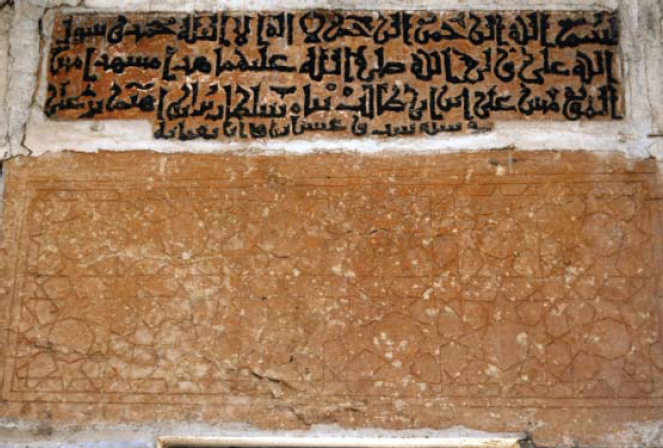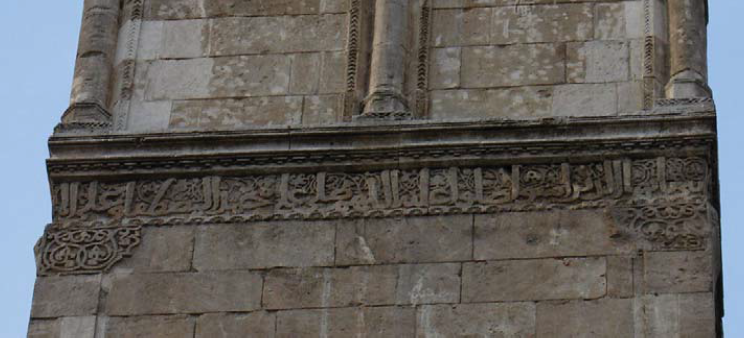The contents of this article were published in the magazine Payam-e Baharistan, in spring of the Iranian year 1390, on pages 781-786. The original Farsi written by Ahmed Khamehyar, supplemented by footnotes and references can be seen here. This is a translation of the general contents of that article, but not a complete translation of it.
Stone Inscriptions in the Villages of Adlab
In many villages and historical ruins of the region of Adlab, old stone wall inscriptions and grave-stone inscriptions can be found. These are generally written in very simple Arabic and can be dated back to the early Islamic centuries. Some of these inscriptions also have passages that tend to signify Shi’a presence in the area. One of these can be located on an ancient wall, in the village of Bara (33 km south of Adlab), in Arabic with the date 461 Hijri. In the corner of it, the statement: “محمد وعلی، کلاهما املی” is inscribed – meaning, Muhammad and Ali, both of them are my hope.
Inscriptions on the front of ‘Mashad of Imam Ali’, in the city of Ma’arrah Misrin
Ma’arrah Misrin is a small city located approximately 11 km north of Adlab. Its history can be traced back to before Islam, and it was conquered by the Muslims in 16th Hijri under the command of Abu Ubaydah bin al-Jarrah (d. 18 Hijri). This city was one of the cities where the Shi’a population was significant, however today they do not number more than a few thousand. In areas where the Shi’as would reside, there is a place of visitation that dates back to a thousand years ago, known as ‘Mashad of Imam Ali’ by its residents.
In historical reports, this place has not been mentioned, and no one today – including the residents of the area – seems to know much about its historical past or its relationship to Imam Ali [as]. It is highly probable that this Mashad was a place where someone had seen a dream and subsequently the place was termed as his [as] Mashad. These type of visitation sites were common during the early centuries of the Hijrah, particularly in Syria and Egypt.
The Mashad consists of a very simple building, and consists of a small hall towards its south and a small courtyard to its north. A dome also exists above the hall. The entrance to the building is through the south-side of the courtyard. The building resembles a mosque, and resembles the Maqam of Ibrahim Khalil [as] located in the citadel of Halab – from the remnants of the period of Bani Mardas.
On the front of the building, there is a stone that is a showcase of Islamic geometry, and on top of this design is an inscription of four lines written in Kufan script without any dots. Based on that, the architecture of the Mashad can be understood as Sultan bin Ibrahim bin Ali and its date of construction can be pin-pointed to the year 426 Hijri. This date coincides with the government of Nasr bin Salih bin Mardas (420-429 Hijri) in that same region. The content of the inscription is as follow:
Line 1: In the Name of Allah, The Most Beneficent, The Most Merciful, There is no God but Allah, Muhammad is the Messenger
Line 2: Of Allah, Ali is the Friend of Allah, Peace of Allah be upon both of them, This is the Mashad of Amir
Line 3: al-Mu’mineen Ali bin Abi Talib, Constructed by Sultan bin Ibrahim bin Ali
Line 4: In the year 426
On the left side of its entrance, another inscription exists which suggests that the Mashad was renovated in 1378 Hijri by Jameel Rahhal, the head of the Shi’a committee dealing with endowments in M’arrah Misrin.
 Picture by original author [Ahmed Khamehyar]
Picture by original author [Ahmed Khamehyar]
Inscription on the Minarets of the Congregational Mosque of Halab
The minarets of the congregational mosque of Halab were completely destroyed during the Syrian war on Wednesday, 24th April 2013.
The congregational Umayyad mosque of Halab, is one of the most important mosques from the Umayyad dynasty, which was constructed near the end of the first century Hijri. It has been reported that the Umayyad caliph, Sulayman bin Abd al-Malik (96-99 Hijri), constructed it in order to compete with the Umayyad mosque in Damascus which was constructed under the reign of his brother Walid bin Abd al-Malik (86-96 Hijri). However, based on another report, the Umayyad mosque in Halab was also constructed by Walid bin Abd al-Malik. During the subsequent years, this mosque came under attack at different times or was burnt down, but was always reconstructed again. One of the most notable events was the great fire of the year 564 Hijri, ignited by the Ismailis. After this fire, this mosque was reconstructed by Sultan Nur al-Deen Mahmud bin Zangi (541-569 Hijri), and was expanded, and the style that one sees today is from that era.
The Umayyad mosque of Halab, due to one of the tomb of Prophet Zakariyyah [as] in its hall[1], is also known as the Mosque of Zakariyyah [as] by the people of Halab. On the north-west side of the courtyard exists a minaret with a square base of 4.95 m sq and a height of 45 m. This minaret is considered one of the most beautiful in terms of decoration and its architectural design, and is considered one of its kind in Syria. The frame of the minaret was constructed with five floors with different decorations and inscriptions written in Kufan and Thuluth calligraphy between every connection point between the floors.
The inscription above the third floor in Thuluth calligraphy has a Bismillah with a portion of verse 56 from Surah al-Ahzab, and a Salawat on the 14 infallibles written on it. The complete text of it is as follow:
The East Side: In the Name of Allah, The Most Beneficent, The Most Merciful – Surely Allah, and His angels send blessings upon the
The South Side: Messenger, O you who believe, Send your blessings upon him – O Allah, Send your blessings upon Muhammad al-Mustafa and Upon
The West Side: Murtadha, and Fatima al-Zahra, and Hasan and Husayn, and upon Muhammad, and Ja’far, and Musa, and Ali
The North Side: al-Ridha, and Muhammad, and Ali, and Hasan, and al-Hujjah al-Qaim, and raise their lights and have mercy upon their friends

Ibn Shaddad Halabi (d. 684 Hijri) narrates from Baha al-Deen Abu Muhammad Hasan bin Ibrahim bin Sa’eed bin Yahya (a person from the family of Bani Khashhab), reports that the uncle of his father – Fakhr al-Din Abu al-Hasan Muhammad bin Yahya – completed the construction of the minaret in the year 482 Hijri.
Likewise, Ibn Adeem Halabi (d. 660 Hijri) narrates from Udhaymi (d. 556 Hijri) that in the year 482 Hijri, the minarets of the congregational mosque of Halab were constructed under Qadhi Abu al-Hasan Muhammad bin Yahya bin Muhammad bin Khashhab during the reign of Qaseem al-Dawlah Aq Sunqur – the governor of Halab during the Seljuk dynasty. Based on this, Ibn Khasshab wrote the name of Aq Sunqur on the minaret and then went to him to get his approval for constructing the minaret of Halab. Ibn Adeem says in another place that the minaret of Halab was renovated during the reign of Qaseem al-Dawlah in the year 482 Hijri.
Ibn Abi Tayy (d. 630 Hijri) a Shi’a historian of Halab writes in his work of history that: The minarets were constructed during the time of Sabiq bin Mahmud bin Salih (bin Mardas), by Qadhi Abu al-Hasan bin Khashhab. It’s architect was a person from Sarmin, who finished its base with water and strengthened its stones with iron and lead grapplings. He finished the construction of the minaret during the reign of Qaseem al-Dawlah Aq Sunqur.
Besides the aforementioned inscription, another inscription on another minaret tells the tale of its construction. On the first-floor of the minaret on the south side, there is an inscription of two lines which has the name of the architect written on it, Hasan bin Mufrih al-Surmani, and its date of construction is written as 483 Hijri. Based on an inscription written above this floor, this minaret was renovated during the time of Malik-Shah Seljuki. An inscription at the bottom of this same inscription has the name of Qaseem al-Dawlah Aq Sunqur. Based on an inscription above the fifth floor of the minaret, its construction was completed during the reign of Tatash Seljuk.
After looking at all of these statements and taking into consideration the content of the inscriptions, the following conclusion can be derived:
The construction began during the reign of Sabiq bin Mahmud Mardasi (478 – 482). Then during the reign of Qaseem al-Dawlah Aq Sunqur (487 – 488), the governor of Halab during the Seljuk Dynasty and contemporary to two kings of this time – Malik-Shah and Tatash – the construction ended. From the sources of history, it is apparent that the construction of the minarets was undertaken by Fakhr al-Deen Abu al-Hasan Muhammad bin Yahya bin Muhammad bin Khashhab – famously known as Abu al-Hasan bin Khashhab. He was from a religious Shi’a family of Bani Khashhab of Halab and he was a judge of the city during the Seljuk dynasty. This explains the inscriptions with Shi’i contents on the minarets.
—
[1] Another report suggests that this tomb actually possesses the head of Yahya bin Zakariyah [as], which was moved from the Citadel of Halab to this mosque
Sayyid Ali studied in the seminary of Qom from 2012 to 2021, while also concurrently obtaining a M.A in Islamic Studies from the Islamic College of London in 2018. In the seminary he engaged in the study of legal theory, jurisprudence and philosophy, eventually attending the advanced kharij of Usul and Fiqh in 2018. He is currently completing his Masters of Education at the University of Toronto and is the head of a private faith-based school in Toronto, as well as an instructor at the Mizan Institute and Mufid Seminary.


Hello, I need your help with Farsi and the ILIS website.